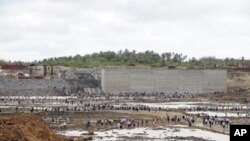Sri Lanka has opened a new port built with Chinese assistance. It is one of the biggest infrastructure projects in the country, which is rebuilding new roads, railways, and ports following the end of a long civil conflict in the country.
The $1.5 billion deep sea port at Hambantota is located in the Indian Ocean along one of the world's busiest shipping lanes.
The government hopes to get business from some of the 70,000 ships that ply this route every year. The port has four terminals, and will handle up to 2,500 ships annually in the first phase. The first ships are expected to berth at the port in November.
Sri Lankan authorities say Hambantota will set the country on the path of economic recovery after a three-decades long civil war, and help the island nation emerge as a regional trading hub.
Deshal Demel, an economist with Colombo's Institute of Policy Studies, says Sri Lanka's geographical location midway between "East and West" is a huge advantage.
"So ships that are traveling from say the eastern part of the world that is Japan, Korea and China to the west America and Europe, they would find that Sri Lanka would be a useful stoppage point in terms of refueling and any other services that a ship would require such as repairs and so on and so forth," said Demel.
China has loaned $425 million to build the first phase of the Hambantota port, and is closely involved with its construction.
That has raised some concern in India. Strategic analysts in New Delhi worry that China is expanding its influence in the South Asian region, and is surrounding India with a so-called "string of pearls" or a network of ports that could pose a potential security concern. China is also building port facilities in Pakistan, Burma, and Bangladesh.
Sri Lankan authorities dismiss such concerns, saying that China's involvement in the project is purely commercial.
The port is part of Sri Lanka's effort to rebuild its infrastructure after its civil war ended last year.
Demel says the war had constrained the government's ability to spend huge sums on infrastructure.
"We are catching up on what really we should have been doing, would have been doing if not for the conflict. As a result we are finally being able to upgrade our roads. Roads is certainly one big area. And the other big area is energy," said Demel.
Sri Lankan authorities say these projects, which are expected to cost up to $6 billion, will transform the nation's economy.
Sri Lanka Launches New Port Built With Chinese Assistance







